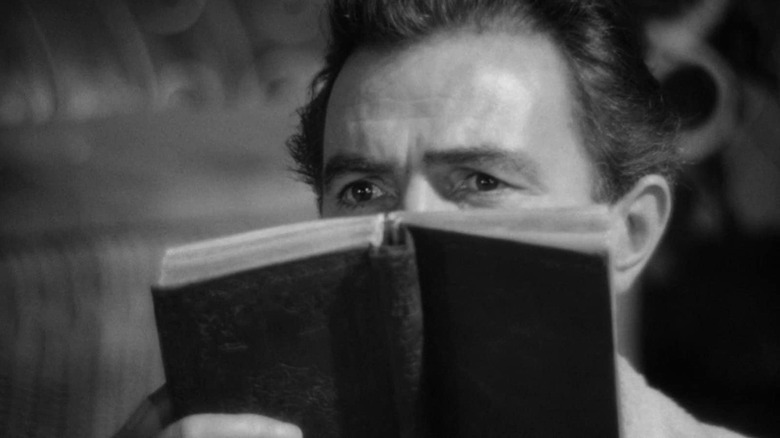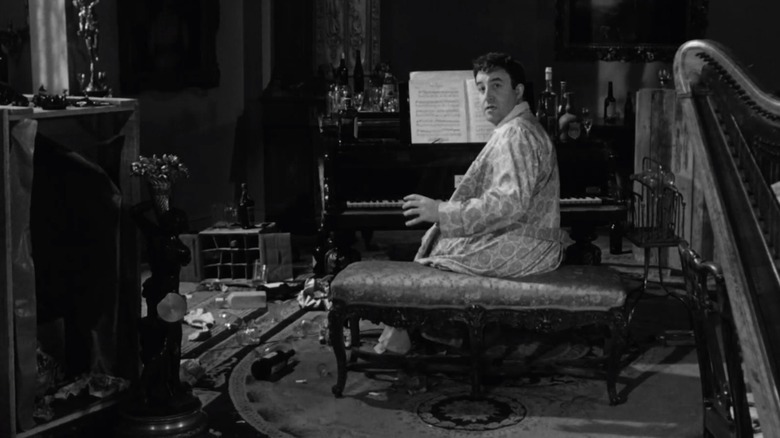Stanley Kubrick Needed A New Approach To The Way Lolita Tells Its Story
Despite its controversial subject matter, which involves a middle-aged man of letters obsessing over a 12-year-old "nymphet" (his own stepdaughter, no less), Vladimir Nabokov's 1955 book "Lolita" is often regarded as one of the finest novels ever written. In 1998, the year that a new Adrian Lyne adaptation of "Lolita," starring Jeremy Irons and Dominique Swain, premiered on Showtime, Modern Library named Nabokov's book the fourth-best English-language novel published by Random House in the 20th century. This was the second attempt at a film adaptation of "Lolita;" the first came in 1962 when Stanley Kubrick was in the director's chair.
Kubrick's adaptation of "Lolita" works backward from the climax of Nabokov's novel, as Humbert Humbert (James Mason) confronts and shoots his drunken counterpart, Clare Quilty (Peter Sellers), in his mansion. The film magnifies Quilty's role, with Sellers even adopting a German disguise at one point, similar to how he would play multiple roles two years later in "Dr. Strangelove."
Shuffling the order of events in "Lolita" was a calculated move on Kubrick's part. In an interview with Joseph Gelmis in the late 1960s (via Scraps from the Loft), Kubrick said:
"I discussed this approach with Nabokov at the very outset, and he liked it. One of the basic problems with the book, and with the film even in its modified form, is that the main narrative interest boils down to the question 'Will Humbert get Lolita into bed?' And you find in the book that, despite the brilliant writing, the second half has a drop in narrative interest after he does. We wanted to avoid this problem in the film, and Nabokov and I agreed that if we had Humbert shoot Quilty without explanation at the beginning, then throughout the film the audience would wonder what Quilty was up to."
The Clare Quilty Show
Though Vladimir Nabokov was the sole credited screenwriter for "Lolita" and received an Oscar nomination for his work, the first draft of his script was over 400 pages. Since each page of a script usually equals about a minute of screen time, this means his original version would have been almost seven hours long, more like a TV miniseries than a movie.
Stanley Kubrick and producer James B. Harris reportedly rewrote much of the "Lolita" script themselves, and in doing so, they reshaped the narrative, only using about 20% of what Nabokov had written. "Of course, you obviously sacrifice a great ending by opening with Quilty's murder," Kubrick conceded, "but I felt it served a worthwhile purpose."
By beginning in media res and then flashing back four years, the effect was to throw mystery on Humbert's motive and turn "Lolita" into something of a why-done-it (as opposed to the conventional murder-mystery model of a whodunit). This, at least, was one change to the story that received Nabokov's blessing, though he wasn't involved much in the production process beyond the early writing stages and would be surprised by some of the other alterations Kubrick made to "Lolita."
The Showtime adaptation of "Lolita" is comparatively more faithful, though it was slightly less well-received and had difficulty securing U.S. theatrical distribution, just as Kubrick had difficulty finding U.S. funding. In this version, Frank Langella plays Quilty, and he only shows up late in the movie. Kubrick, by contrast, was so enamored of Sellers and his character as a mirror image of Humbert's dark side that he almost turned "Lolita" into The Clare Quilty Show at times. As others have noted, the first and last word of Nabokov's novel is "Lolita," whereas the first and last word of Kubrick's film is "Quilty."

